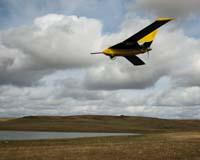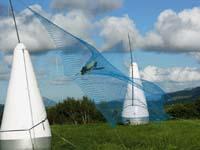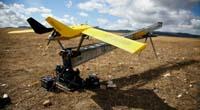The big brother of paper planes
2007/01/01 Kortabitarte Egiguren, Irati - Elhuyar Zientzia Iturria: Elhuyar aldizkaria

Aerovision Vehiculos Aereos S.L. Recently created company that designs, produces and markets low-cost, driverless flying platforms. Aerovision's first product has been the FULMAR flying platform. The main components of the FULMAR system are a small driverless flyer, a take-off aid system and a control station that is installed on the ground.
A few months ago the Gipuzkoan company successfully held the FULMAR exhibition without driver in Cáceres. For the first time in Spain, such a flight was a success.
In an automatic flight of an hour and a half, he traveled more than 160 km of travel and received various images of the earth responding to the requests of the people who approached this exhibition. The plane was fired from a catapult and later picked up in a network. The objective of the flight was to study the suitability of the plane as a support system in the monitoring and control of forest fires.
Specifically, the company intends to use this aircraft in aerial monitoring and surveillance applications such as fire prevention, traffic monitoring, atmospheric study and detection of chemical contaminants, fisheries study, surveillance of the environment of large infrastructures, etc. To do this, the plane has installed a tripod in which several cameras can be placed. The basic model only carries a conventional camera that uses daylight, but often an additional camera that uses infrared light is applied.
Camera signals can be received in real time at the control station via radio waves. From this control station it is also possible to control the movements and zoomas of the camera located inside the plane. This camera is stable, although the plane moves, stays still and offers slow images. In addition, through the radio waves he gives the order and looks at the place indicated to him, wherever he is.
High autonomy

Despite having travelled 160 km during the demonstration, this small driverless steering platform can travel 800 km for 8 hours on scheduled autonomous flight through the GPS navigation system. The maximum distance to the control station is 50 km. It is a low consumption system with great autonomy. In addition, it can fly very fast or very slow thanks to the design structure of the plane, that is, it can fly in a wide range of speeds. In addition, it is able to reach a relatively high height in a very short time, allowing you to overcome without problems any obstacles you find in your way, such as peaks. Take-off, route and airplane landing are automatic. That is, they can be programmed from the control station. The FULMAR system is easy to handle.
After analyzing the design and handling of the plane, we cannot forget the lightness of its structure. It weighs more than paper planes, but nothing compared to real planes. The maximum capacity of the aircraft to take off is 20 Kg, of which 8 Kg are for fuels and cameras. Undoubtedly, the structure of the plane is very light. To achieve this lightness, the aircraft is manufactured mainly in composites materials, such as carbon fiber and kevlar (material used in anti-whale vests, among others). In addition to their lightness, these materials are very resistant and do not explode in case of plane crash.
In that first demonstration there was no accident or other scare. Therefore, researchers believe that in the future the FULMAR system could be a complement to the most expensive resources so far, such as helicopters and planes, and in some cases an alternative system for fire tracking, among others.




